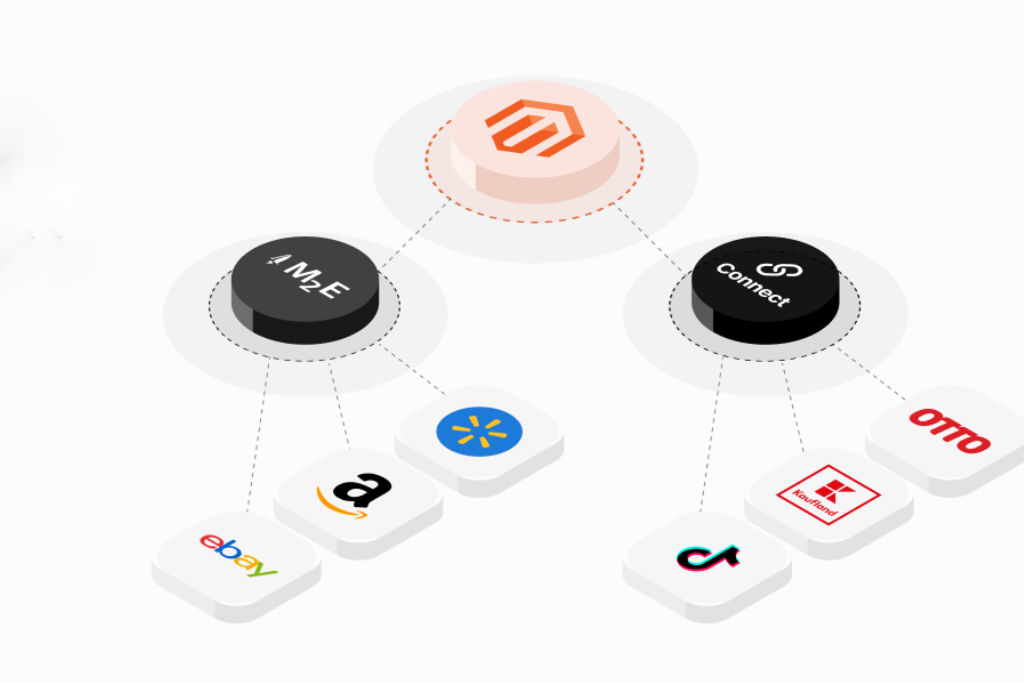From Online Store to Marketplaces: Reaching New Sales Channels
Marketplaces are nowadays some of the most accessed shopping destinations. Their ability to showcase a vast array of prices, driven by sellers constantly adjusting to fight for visibility and sales, makes competing against them very difficult. For big sellers, they pose a threat, as it’s nearly impossible to match this level of price competition without sacrificing margins. For small shops, marketplaces are a God-sent, as they offer an essential platform to gain visibility without investing heavily in traffic acquisition. One thing is for sure: marketplaces have revolutionized retail and their continuous investment in complex AI-driven tools for personalized shopping journeys and product discovery are creating a real shift in how people buy and sell products online.
We’re experts in eCommerce development services and we’re here to help you choose the right solution for your business.
Indeed, the fees that they charge will always generate that love/hate relationship. Fees vary based on sales volume, fulfillment choices, and product categories. Amazon for example charges a fee per item sold, plus a referral fee. Sellers using Fulfillment by Amazon (FBA) also incur storage and handling fees. Same happens with all major Marketplaces, so yes, margins drop.
But with millions of potential shoppers actively browsing these platforms daily, marketplaces provide unmatched visibility and access to new audiences, making them invaluable for businesses looking to scale and diversify.
Large, reputable brands leverage these platforms to expand their reach, positioning their products before a broad audience that frequents these sites for their reliability and convenience and in the meantime, smaller merchants have a unique opportunity to increase their sales, which otherwise would be impossible without enormous marketing budgets.
Benefits of Selling on Marketplaces
First of all, marketplaces benefit from a wide exposure, drawing in shoppers from all walks of life. This exposure is especially valuable for brands looking to establish themselves in new markets or reach demographics they might not typically attract through their website alone. Either big or small, every retailer wants to connect with a vast, ready-made audience that’s actively searching for products, and what’s most important – without significant investment in advertising and SEO.

Second, marketplaces offer an invaluable advantage – their reputation for reliability. Established platforms like Amazon, Walmart, and others are well known for their security and buyer protection and the effect extends to the sellers on these platforms, making it easier for new or lesser-known brands to overcome the trust barrier and attract buyers.
Another major benefit, especially for small online stores, is the fact that marketplaces manage payments, offer fulfillment services, and sometimes even handle customer service on behalf of sellers. Take Fulfillment by Amazon (FBA) for example, which takes care of storage, packaging, and shipping. The fees are deducted from sales, so businesses can focus more on sourcing and selling quality products.
For big retailers, selling on marketplaces allows them to diversify their revenue streams. Relying solely on a single website exposes them to various factors like dips in traffic, algorithm changes, or advertising costs, that can impact sales. By selling on multiple marketplaces, businesses create multiple channels for revenue, because they can reach a broader audience across different shopping environments.
Key Marketplaces to Consider
Amazon, eBay, and Walmart are the giants in the eCommerce space. Everyone heard of them, but what is their competitive advantage?
Amazon for example is well known for its personalization algorithms, which are able to offer recommended products tailored to every client’s needs. Newer technologies based on AI like Shopping Guides offer smart assistance, guiding customers in every step of their journey.
eBay, known for its mix of new and used items, appeals to shoppers with its auction model, creating a unique space in the market. Walmart’s marketplace, though newer, leverages Walmart Fulfillment Services (WFS) to reach competitive pricing while ensuring trusted Walmart branding for its partners.
Temu and SHEIN are the new kids on the block from China. Their competitive advantage are the accessible mobile apps which utilize aggressive pricing strategies, backed by heavy social media marketing.
In Romania, eMAG is the largest online marketplace. Founded locally, eMAG offers a vast catalog of products across all major categories. Cheap prices from the two Asian marketplaces – Temu and SHEIN – are a constant threat to eMag too, but by offering reliable shipping and customer service, eMag has managed to build a strong regional presence.
To help retailers, eMAG’s marketplace fees are structured to minimize upfront costs being based on sales. Sellers do not pay for account registration, listing, or account maintenance, making it easier to enter the platform without high initial expenses. Instead, eMAG charges a commission per sale. There is also a Fulfillment by eMAG (FBE) service which will incur additional storage and processing fees.
Integrating Marketplaces with your Online Store
The major eCommerce platforms have understood the need to allow for seamless integration with marketplaces.

The Amazon Sales Channel Extension can be installed on Magento Open Source and Adobe Commerce and with a powerful API, It enables automatic syncing of products, prices, and inventory levels directly from Magento to Amazon Seller Central.
The extension proved reliable but there were times during high-traffic times, such as major shopping events, when users reported that synchronization between Magento and Amazon lagged due to Amazon’s throttling policies. Running the Magento cron more frequently (every five minutes) helped mitigate these delays, but still during peak times, data sync delays remain a known limitation. That’s why some users found that switching to alternative integration tools, like M2E Pro, provided more stability under similar setups.
M2E Pro has the benefit of being a Magento native extension helping to upload inventory and handle listings & orders on all the three largest marketplaces – eBay, Amazon, and Walmart. M2E Pro makes multi-channel sales much easier and faster. Additionally, it imports marketplace orders into Magento, simplifying order management, and provides options for product mapping and setting specific pricing rules to maintain consistency between platforms.
For Shopware, the Shopware Markets plugin is a stable solution for connecting to Amazon and eBay. This plugin allows for the usual synchronization of product data directly from the Shopware interface. It also allows merchants to decide which products to list on each marketplace.
But a standout feature is its flexibility for international sales. Sellers can customize product content, pricing, and shipping details for different countries, with local currency support, making it easier to expand into new regions.
How to Successfully Sell on Marketplaces
First of all, merchants need to know that marketplaces use complex algorithms designed to optimize user experience, recommend products, or automatize dynamic pricing. To make the most of marketplace algorithms, they should optimize their product listings with clear, detailed descriptions, high-quality images, and strategic keyword placement. Most marketplaces, including Amazon and eBay, allow for enhanced content like A+ or rich media, so take advantage of these options to add extra detail.
Also, having competitive prices is key when selling on marketplaces. Amazon encourages competitive pricing strategies by offering a ‘one-seller only’ tool called Buy Box which lets clients add items to their cart or buy them directly and accounts for the majority of sales on Amazon. The tool is offered to only one seller at any given moment. Amazon’s algorithm determines which seller’s offer appears in the Buy Box, based on price, fulfillment method, seller performance, etc.
Many sellers use dynamic pricing tools like Repricer or Price2Spy, which automatically adjust prices based on competitor data. To set up, configure your minimum and maximum acceptable prices in the tool, and allow it to adapt prices in real-time based on market conditions. Also, factor in marketplace fees when setting prices.
Last but not least, make sure that your orders and inventory are perfectly synced between the marketplace and your ecommerce platform. This minimizes errors and enhances customer satisfaction by avoiding issues like canceled orders due to stock discrepancies.
As we explained earlier, major eCommerce platforms offer complex solutions to ensure seamless synchronization, but testing remains a critical step to guarantee reliability. This way, dev teams can identify any issues, such as latency in inventory updates, pricing mismatches, or errors in order processing, before they reach the end customer.
If you want to know more about our list of services at Clever++, please visit our website.




